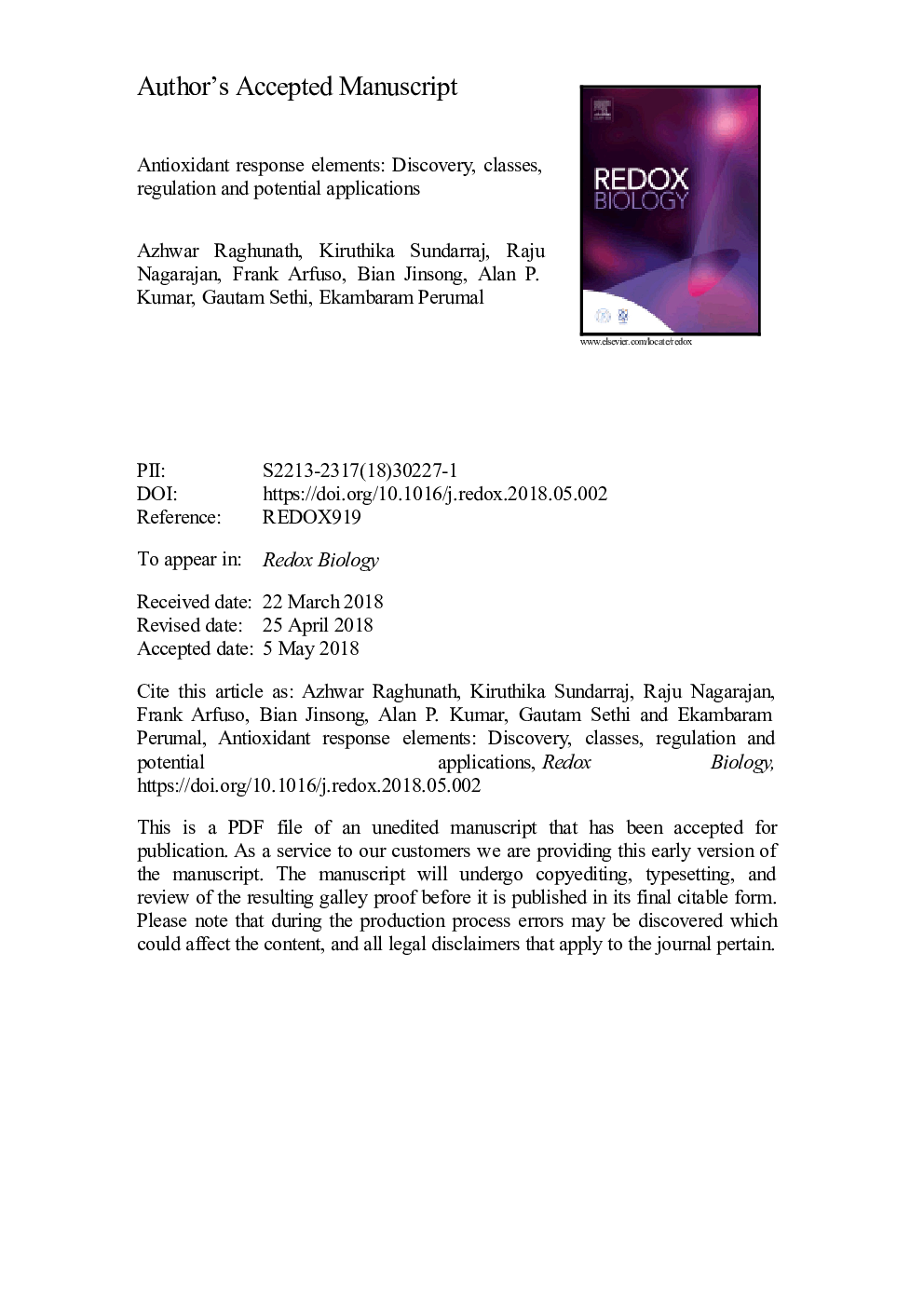| کد مقاله | کد نشریه | سال انتشار | مقاله انگلیسی | نسخه تمام متن |
|---|---|---|---|---|
| 8286382 | 1535833 | 2018 | 61 صفحه PDF | دانلود رایگان |
عنوان انگلیسی مقاله ISI
Antioxidant response elements: Discovery, classes, regulation and potential applications
ترجمه فارسی عنوان
عناصر پاسخ آنتی اکسیدان: کشف، کلاس ها، تنظیمات و برنامه های کاربردی بالقوه
دانلود مقاله + سفارش ترجمه
دانلود مقاله ISI انگلیسی
رایگان برای ایرانیان
کلمات کلیدی
PI3KCRENAPATF4TBHQCATSNPsNCBIBLAeGFPtPANrf2GSHGSTChIP-SeqHO-1CTDPWMPHEAHEAP-1MAPTNRF1VCPHRENTDBTBNQO1XREtert-butylhydroquinonePYRHemeoxygenase-1β-NF3-methylcholanthreneSMAFβ-TrCPHRD1FTLNQRNAD(P)H:quinone reductaseTPA-responsive elementB[α]PKeap1/Nrf2/ARE pathwayCNC-bZIPferritin light polypeptideHBE1keap1 - buy1EpRE - EprePMA - LDC ها3-MC - MC-3NAD(P)H quinone dehydrogenase 1 - NAD (P) H کینون دهیدروژناز 1Phosphatidylinositol-4,5-bisphosphate 3-kinase - Phosphatidylinositol-4،5-bisphosphate 3-kinasePHx - PHXROS - ROSβ-naphthoflavone - β-naftoflavoneβ-lactamase - β-لاکتامازAryl hydrocarbon - آرویل هیدروکربنFluorescence resonance energy transfer - انتقال انرژی رزونانس FluorescenceFRET - انتقال انرژی رزونانسی فورسترBenzo[a]pyrene - بنزو [a] پییرنBACH - بچOxidative stress - تنش اکسیداتیوchromatin immunoprecipitation sequencing - توالی آمپول اکسایش کروماتینHare - خرگوشC-terminal domain - دامنه C ترمینالN-terminal domain - دامنه N-terminalTRE - سهcytochrome P450 1A1 - سیتوکروم P450 1A1endoplasmic reticulum - شبکه آندوپلاسمی antioxidant response elements - عناصر پاسخ آنتی اکسیدانxenobiotic-responsive element - عنصر واکنش زنجبیلantioxidant response element - عنصر پاسخ آنتی اکسیدانelectrophile-responsive element - عنصر پاسخ دهنده الکتروفیلیcyclic AMP responsive element - عنصر پاسخگو AMP چرخهactivating transcription factor 4 - فعال کردن عامل رونویسی 4Position weight matrix - ماتریس وزن موقعیتMares - مارسMetallothionein - متالوتونیئینNational Center for Biotechnology Information - مرکز ملی اطلاعات بیوتکنولوژیknock-out - ناک اوتNaphthalene - نفتالینARE - هستندPartial hepatectomy - هپاتکتومی جزئیPAHs - هیدروکربن های آروماتیک چند حلقه ایPolyaromatic hydrocarbons - هیدروکربنهای Polyaromaticnuclear envelope - پاکت هسته ایβ-transducin repeat-containing protein - پروتئین حاوی تکرار β-transducinValosin-containing protein - پروتئین حاوی والوسینactivator protein-1 - پروتئین فعال کننده-1enhanced green fluorescent protein - پروتئین فلورسنت سبز افزایش یافته استKelch-like ECH-associated protein 1 - پروتئین مرتبط با ECH کلچ 1microtubule-associated protein tau - پروتئین وابسته به میکروتوبول TauSingle nucleotide polymorphisms - پلیمورفیسم تک نوکلئوتیدیPhenanthrene - پنانترنPyrene - پیرنهAntioxidant genes - ژنهای آنتی اکسیدانchloramphenicol acetyltransferase - کلرامفنیکول استیل ترانسفرازGlutathione - گلوتاتیونglutathione S-transferase - گلوتاتیون S-ترانسفرازReactive oxygen species - گونههای فعال اکسیژنaryl hydrocarbon receptor - گیرنده آرویل هیدروکربن
موضوعات مرتبط
علوم زیستی و بیوفناوری
بیوشیمی، ژنتیک و زیست شناسی مولکولی
سالمندی
چکیده انگلیسی
Exposure to antioxidants and xenobiotics triggers the expression of a myriad of genes encoding antioxidant proteins, detoxifying enzymes, and xenobiotic transporters to offer protection against oxidative stress. This articulated universal mechanism is regulated through the cis-acting elements in an array of Nrf2 target genes called antioxidant response elements (AREs), which play a critical role in redox homeostasis. Though the Keap1/Nrf2/ARE system involves many players, AREs hold the key in transcriptional regulation of cytoprotective genes. ARE-mediated reporter constructs have been widely used, including xenobiotics profiling and Nrf2 activator screening. The complexity of AREs is brought by the presence of other regulatory elements within the AREs. The diversity in the ARE sequences not only bring regulatory selectivity of diverse transcription factors, but also confer functional complexity in the Keap1/Nrf2/ARE pathway. The different transcription factors either homodimerize or heterodimerize to bind the AREs. Depending on the nature of partners, they may activate or suppress the transcription. Attention is required for deeper mechanistic understanding of ARE-mediated gene regulation. The computational methods of identification and analysis of AREs are still in their infancy. Investigations are required to know whether epigenetics mechanism plays a role in the regulation of genes mediated through AREs. The polymorphisms in the AREs leading to oxidative stress related diseases are warranted. A thorough understanding of AREs will pave the way for the development of therapeutic agents against cancer, neurodegenerative, cardiovascular, metabolic and other diseases with oxidative stress.
ناشر
Database: Elsevier - ScienceDirect (ساینس دایرکت)
Journal: Redox Biology - Volume 17, July 2018, Pages 297-314
Journal: Redox Biology - Volume 17, July 2018, Pages 297-314
نویسندگان
Azhwar Raghunath, Kiruthika Sundarraj, Raju Nagarajan, Frank Arfuso, Jinsong Bian, Alan P. Kumar, Gautam Sethi, Ekambaram Perumal,
